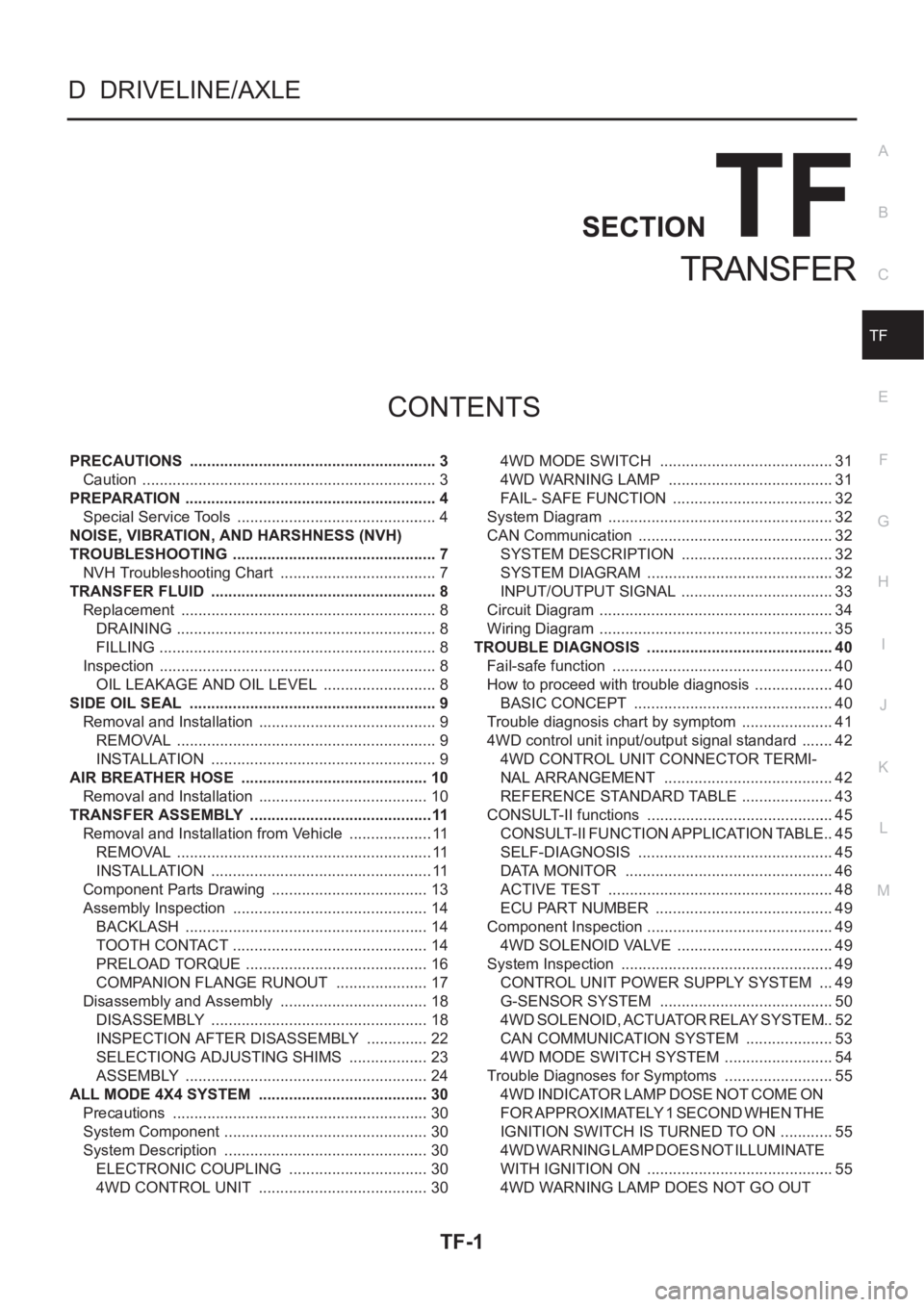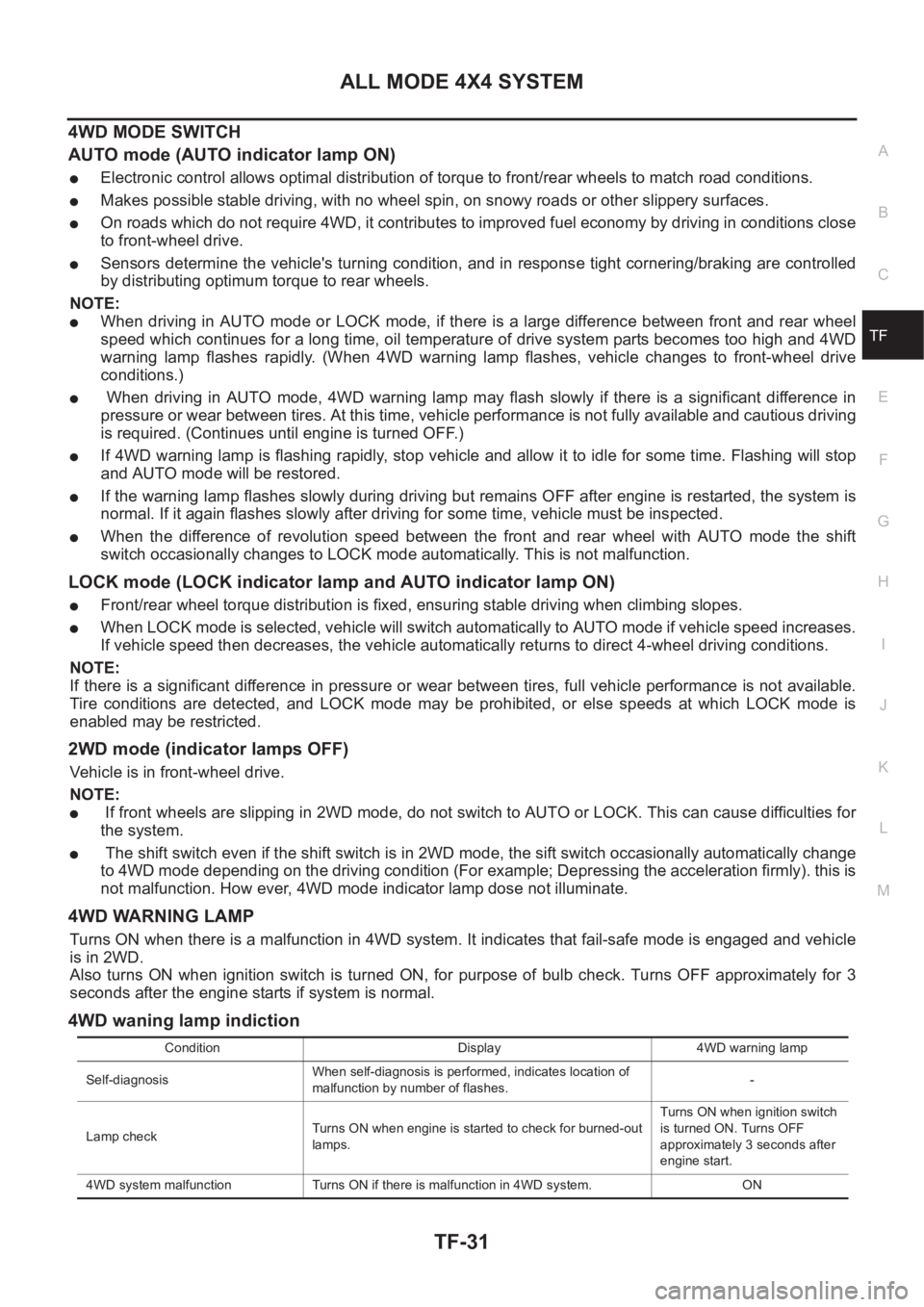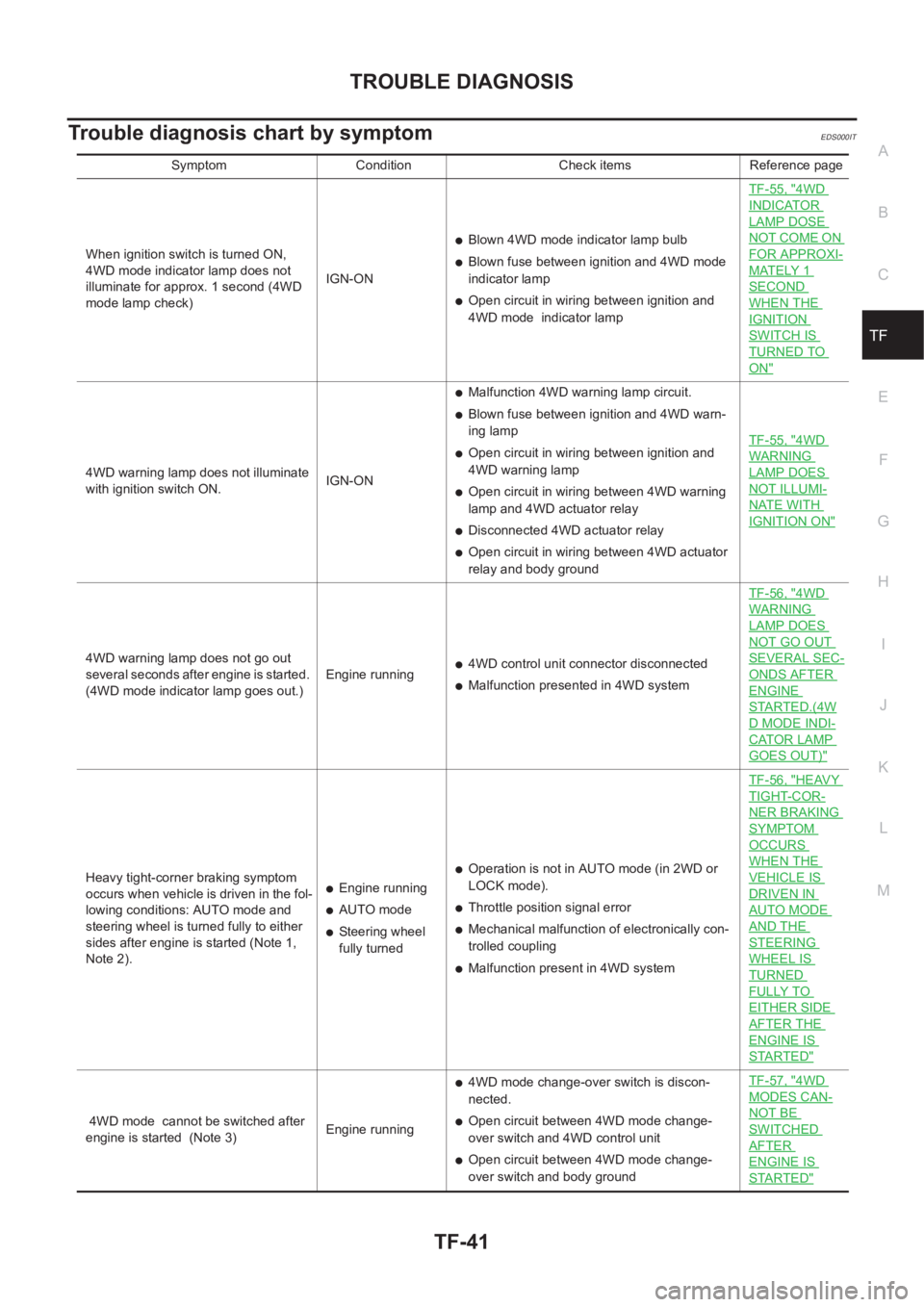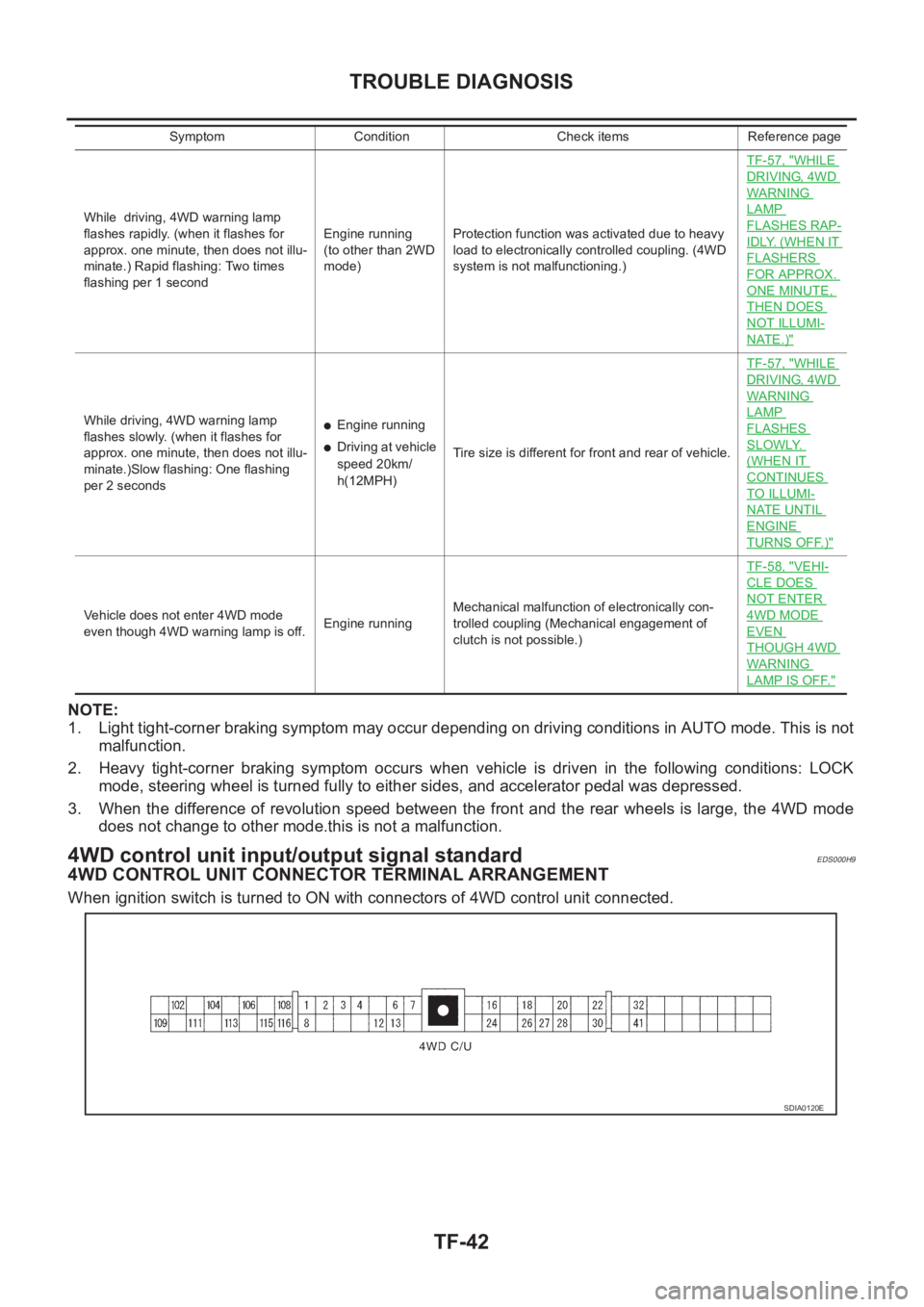2001 NISSAN X-TRAIL ignition
[x] Cancel search: ignitionPage 2487 of 3833
![NISSAN X-TRAIL 2001 Service Repair Manual A/T SHIFT LOCK SYSTEM
AT-409
[ALL]
D
E
F
G
H
I
J
K
L
MA
B
AT
5.CHECK INPUT SIGNAL A/T DEVICE
Turn ignition switch to “OFF” position.
●Check voltage between A/T device harness connector M58 termi NISSAN X-TRAIL 2001 Service Repair Manual A/T SHIFT LOCK SYSTEM
AT-409
[ALL]
D
E
F
G
H
I
J
K
L
MA
B
AT
5.CHECK INPUT SIGNAL A/T DEVICE
Turn ignition switch to “OFF” position.
●Check voltage between A/T device harness connector M58 termi](/manual-img/5/57405/w960_57405-2486.png)
A/T SHIFT LOCK SYSTEM
AT-409
[ALL]
D
E
F
G
H
I
J
K
L
MA
B
AT
5.CHECK INPUT SIGNAL A/T DEVICE
Turn ignition switch to “OFF” position.
●Check voltage between A/T device harness connector M58 terminal 7 and ground.
OK or NG
OK >> GO TO 7.
NG >> GO TO 6.
6.DETECT MALFUNCTIONING ITEM
Check the following items:
1. Harness for short or open between battery and stop lamp switch harness connector 1
2. Harness for short or open between stop lamp switch harness connector 2 and A/T device harness con-
nector 7
3. Fuse
4. Stop lamp switch
–Check continuity between stop lamp switch harness connector M12 terminals 1 (R/Y) and 2 (P).
Check stop lamp switch after adjusting brake pedal — refer to BR-6, "
BRAKE PEDAL" .
OK or NG
OK >> GO TO 7.
NG >> Repair or replace damaged parts. Voltage:
Brake pedal depressed:
Battery voltage
Brake pedal released:
0V
SCIA1166E
SAT661K
Page 2488 of 3833
![NISSAN X-TRAIL 2001 Service Repair Manual AT-410
[ALL]
A/T SHIFT LOCK SYSTEM
7. CHECK GROUND CIRCUIT
1. Turn ignition switch to “OFF” position.
2. Disconnect A/T device harness connector.
3. Check continuity between A/T device harness con NISSAN X-TRAIL 2001 Service Repair Manual AT-410
[ALL]
A/T SHIFT LOCK SYSTEM
7. CHECK GROUND CIRCUIT
1. Turn ignition switch to “OFF” position.
2. Disconnect A/T device harness connector.
3. Check continuity between A/T device harness con](/manual-img/5/57405/w960_57405-2487.png)
AT-410
[ALL]
A/T SHIFT LOCK SYSTEM
7. CHECK GROUND CIRCUIT
1. Turn ignition switch to “OFF” position.
2. Disconnect A/T device harness connector.
3. Check continuity between A/T device harness connector M58 terminal 6 (B) and ground.
If OK, check harness for short to ground and short to power.
OK or NG
OK >> GO TO 8.
NG >> Repair open circuit or short to ground or short to power
in harness or connectors.
8. CHECK PARK POSITION SWITCH AND RELAY CIRCUIT (COIL SIDE)
Check continuity between A/T device harness connector M58 terminals 6 (B) and 7 (P).
OK or NG
OK >> GO TO 9.
NG >> Replace park position switch or relay.
9. CHECK SHIFT LOCK SOLENOID AND RELAY CIRCUIT (POINT SIDE)
1. Connect A/T device harness connector.
2. Turn ignition switch to “ON” position.
3. Check operation sound.
OK or NG
OK >> GO TO 10.
NG >> Replace shift lock solenoid or relay.Continuity should exist.
SCIA0784E
SAT665K
Condition Brake pedal Operation sound
When ignition switch is turned to
“ON” position and selector lever
is set in “P” position.Depressed Yes
Released No
Page 2489 of 3833
![NISSAN X-TRAIL 2001 Service Repair Manual A/T SHIFT LOCK SYSTEM
AT-411
[ALL]
D
E
F
G
H
I
J
K
L
MA
B
AT
10.CHECK SHIFT LOCK OPERATION
1. Reconnect shift lock harness connector.
2. Turn ignition switch from “OFF” to “ON” position. (Do n NISSAN X-TRAIL 2001 Service Repair Manual A/T SHIFT LOCK SYSTEM
AT-411
[ALL]
D
E
F
G
H
I
J
K
L
MA
B
AT
10.CHECK SHIFT LOCK OPERATION
1. Reconnect shift lock harness connector.
2. Turn ignition switch from “OFF” to “ON” position. (Do n](/manual-img/5/57405/w960_57405-2488.png)
A/T SHIFT LOCK SYSTEM
AT-411
[ALL]
D
E
F
G
H
I
J
K
L
MA
B
AT
10.CHECK SHIFT LOCK OPERATION
1. Reconnect shift lock harness connector.
2. Turn ignition switch from “OFF” to “ON” position. (Do not start engine.)
3. Recheck shift lock operation.
OK or NG
OK >>INSPECTION END
NG >> GO TO 11.
11 . CHECK A/T DEVICE INSPECTION
1. Perform A/T device input/output signal inspection test.
2. If NG, recheck harness connector connection.
OK or NG
OK >>INSPECTION END
NG >> Repair or replace damaged parts.
Page 2491 of 3833
![NISSAN X-TRAIL 2001 Service Repair Manual KEY INTERLOCK CABLE
AT-413
[ALL]
D
E
F
G
H
I
J
K
L
MA
B
AT
2. Remove lock plate from steering lock assembly and remove key
interlock cable.
InstallationECS0040B
1. Turn ignition key to lock position.
NISSAN X-TRAIL 2001 Service Repair Manual KEY INTERLOCK CABLE
AT-413
[ALL]
D
E
F
G
H
I
J
K
L
MA
B
AT
2. Remove lock plate from steering lock assembly and remove key
interlock cable.
InstallationECS0040B
1. Turn ignition key to lock position.](/manual-img/5/57405/w960_57405-2490.png)
KEY INTERLOCK CABLE
AT-413
[ALL]
D
E
F
G
H
I
J
K
L
MA
B
AT
2. Remove lock plate from steering lock assembly and remove key
interlock cable.
InstallationECS0040B
1. Turn ignition key to lock position.
2. Set A/T selector lever to P position.
3. Set key interlock cable to steering lock assembly and install lock
plate.
4. Clamp cable to steering column and fix to control cable with
band.
5. Insert interlock rod into adjuster holder.
6. Install casing cap to bracket.
7. Move slider in order to fix adjuster holder to interlock rod.
SAT854J
SAT854J
SAT804E
SAT805E
Page 2611 of 3833

TF-1
TRANSFER
D DRIVELINE/AXLE
CONTENTS
C
E
F
G
H
I
J
K
L
M
SECTION
A
B
TF
TRANSFER
PRECAUTIONS .......................................................... 3
Caution ..................................................................... 3
PREPARATION ........................................................... 4
Special Service Tools ............................................... 4
NOISE, VIBRATION, AND HARSHNESS (NVH)
TROUBLESHOOTING ................................................ 7
NVH Troubleshooting Chart ..................................... 7
TRANSFER FLUID ..................................................... 8
Replacement ............................................................ 8
DRAINING ............................................................. 8
FILLING ................................................................. 8
Inspection ................................................................. 8
OIL LEAKAGE AND OIL LEVEL ........................... 8
SIDE OIL SEAL .......................................................... 9
Removal and Installation .......................................... 9
REMOVAL ............................................................. 9
INSTALLATION ..................................................... 9
AIR BREATHER HOSE ............................................ 10
Removal and Installation ........................................ 10
TRANSFER ASSEMBLY ...........................................11
Removal and Installation from Vehicle .................... 11
REMOVAL ............................................................ 11
INSTALLATION .................................................... 11
Component Parts Drawing ..................................... 13
Assembly Inspection .............................................. 14
BACKLASH ......................................................... 14
TOOTH CONTACT .............................................. 14
PRELOAD TORQUE ........................................... 16
COMPANION FLANGE RUNOUT ...................... 17
Disassembly and Assembly ................................... 18
DISASSEMBLY ................................................... 18
INSPECTION AFTER DISASSEMBLY ............... 22
SELECTIONG ADJUSTING SHIMS ................... 23
ASSEMBLY ......................................................... 24
ALL MODE 4X4 SYSTEM ........................................ 30
Precautions ............................................................ 30
System Component ................................................ 30
System Description ................................................ 30
ELECTRONIC COUPLING ................................. 30
4WD CONTROL UNIT ........................................ 304WD MODE SWITCH ......................................... 31
4WD WARNING LAMP ....................................... 31
FAIL- SAFE FUNCTION ...................................... 32
System Diagram ..................................................... 32
CAN Communication ...........................................
... 32
SYSTEM DESCRIPTION .................................... 32
SYSTEM DIAGRAM ............................................ 32
INPUT/OUTPUT SIGNAL .................................... 33
Circuit Diagram ....................................................... 34
Wiring Diagram ....................................................... 35
TROUBLE DIAGNOSIS ............................................ 40
Fail-safe function .................................................... 40
How to proceed with trouble diagnosis ................... 40
BASIC CONCEPT ............................................... 40
Trouble diagnosis chart by symptom ...................... 41
4WD control unit input/output signal standard ........ 42
4WD CONTROL UNIT CONNECTOR TERMI-
NAL ARRANGEMENT ........................................ 42
REFERENCE STANDARD TABLE ...................... 43
CONSULT-II functions ............................................ 45
CONSULT-II FUNCTION APPLICATION TABLE ... 45
SELF-DIAGNOSIS .............................................. 45
DATA MONITOR ................................................. 46
ACTIVE TEST ..................................................... 48
ECU PART NUMBER .......................................... 49
Component Inspection ............................................ 49
4WD SOLENOID VALVE ..................................... 49
System Inspection .................................................. 49
CONTROL UNIT POWER SUPPLY SYSTEM .... 49
G-SENSOR SYSTEM ......................................... 50
4WD SOLENOID, ACTUATOR RELAY SYSTEM ... 52
CAN COMMUNICATION SYSTEM ..................... 53
4WD MODE SWITCH SYSTEM .......................... 54
Trouble Diagnoses for Symptoms .......................... 55
4WD INDICATOR LAMP DOSE NOT COME ON
FOR APPROXIMATELY 1 SECOND WHEN THE
IGNITION SWITCH IS TURNED TO ON ............. 55
4WD WARNING LAMP DOES NOT ILLUMINATE
WITH IGNITION ON ............................................ 55
4WD WARNING LAMP DOES NOT GO OUT
Page 2641 of 3833

ALL MODE 4X4 SYSTEM
TF-31
C
E
F
G
H
I
J
K
L
MA
B
TF
4WD MODE SWITCH
AUTO mode (AUTO indicator lamp ON)
●Electronic control allows optimal distribution of torque to front/rear wheels to match road conditions.
●Makes possible stable driving, with no wheel spin, on snowy roads or other slippery surfaces.
●On roads which do not require 4WD, it contributes to improved fuel economy by driving in conditions close
to front-wheel drive.
●Sensors determine the vehicle's turning condition, and in response tight cornering/braking are controlled
by distributing optimum torque to rear wheels.
NOTE:
●When driving in AUTO mode or LOCK mode, if there is a large difference between front and rear wheel
speed which continues for a long time, oil temperature of drive system parts becomes too high and 4WD
warning lamp flashes rapidly. (When 4WD warning lamp flashes, vehicle changes to front-wheel drive
conditions.)
● When driving in AUTO mode, 4WD warning lamp may flash slowly if there is a significant difference in
pressure or wear between tires. At this time, vehicle performance is not fully available and cautious driving
is required. (Continues until engine is turned OFF.)
●If 4WD warning lamp is flashing rapidly, stop vehicle and allow it to idle for some time. Flashing will stop
and AUTO mode will be restored.
●If the warning lamp flashes slowly during driving but remains OFF after engine is restarted, the system is
normal. If it again flashes slowly after driving for some time, vehicle must be inspected.
●When the difference of revolution speed between the front and rear wheel with AUTO mode the shift
switch occasionally changes to LOCK mode automatically. This is not malfunction.
LOCK mode (LOCK indicator lamp and AUTO indicator lamp ON)
●Front/rear wheel torque distribution is fixed, ensuring stable driving when climbing slopes.
●When LOCK mode is selected, vehicle will switch automatically to AUTO mode if vehicle speed increases.
If vehicle speed then decreases, the vehicle automatically returns to direct 4-wheel driving conditions.
NOTE:
If there is a significant difference in pressure or wear between tires, full vehicle performance is not available.
Tire conditions are detected, and LOCK mode may be prohibited, or else speeds at which LOCK mode is
enabled may be restricted.
2WD mode (indicator lamps OFF)
Vehicle is in front-wheel drive.
NOTE:
● If front wheels are slipping in 2WD mode, do not switch to AUTO or LOCK. This can cause difficulties for
the system.
● The shift switch even if the shift switch is in 2WD mode, the sift switch occasionally automatically change
to 4WD mode depending on the driving condition (For example; Depressing the acceleration firmly). this is
not malfunction. How ever, 4WD mode indicator lamp dose not illuminate.
4WD WARNING LAMP
Turns ON when there is a malfunction in 4WD system. It indicates that fail-safe mode is engaged and vehicle
is in 2WD.
Also turns ON when ignition switch is turned ON, for purpose of bulb check. Turns OFF approximately for 3
seconds after the engine starts if system is normal.
4WD waning lamp indiction
Condition Display 4WD warning lamp
Self-diagnosisWhen self-diagnosis is performed, indicates location of
malfunction by number of flashes.-
Lamp checkTurns ON when engine is started to check for burned-out
lamps.Turns ON when ignition switch
is turned ON. Turns OFF
approximately 3 seconds after
engine start.
4WD system malfunction Turns ON if there is malfunction in 4WD system. ON
Page 2651 of 3833

TROUBLE DIAGNOSIS
TF-41
C
E
F
G
H
I
J
K
L
MA
B
TF
Trouble diagnosis chart by symptomEDS000IT
Symptom Condition Check items Reference page
When ignition switch is turned ON,
4WD mode indicator lamp does not
illuminate for approx. 1 second (4WD
mode lamp check)IGN-ON
●Blown 4WD mode indicator lamp bulb
●Blown fuse between ignition and 4WD mode
indicator lamp
●Open circuit in wiring between ignition and
4WD mode indicator lampTF-55, "
4WD
INDICATOR
LAMP DOSE
NOT COME ON
FOR APPROXI-
MATELY 1
SECOND
WHEN THE
IGNITION
SWITCH IS
TURNED TO
ON"
4WD warning lamp does not illuminate
with ignition switch ON.IGN-ON
●Malfunction 4WD warning lamp circuit.
●Blown fuse between ignition and 4WD warn-
ing lamp
●Open circuit in wiring between ignition and
4WD warning lamp
●Open circuit in wiring between 4WD warning
lamp and 4WD actuator relay
●Disconnected 4WD actuator relay
●Open circuit in wiring between 4WD actuator
relay and body groundTF-55, "
4WD
WARNING
LAMP DOES
NOT ILLUMI-
NATE WITH
IGNITION ON"
4WD warning lamp does not go out
several seconds after engine is started.
(4WD mode indicator lamp goes out.)Engine running●4WD control unit connector disconnected
●Malfunction presented in 4WD systemTF-56, "
4WD
WARNING
LAMP DOES
NOT GO OUT
SEVERAL SEC-
ONDS AFTER
ENGINE
STARTED.(4W
D MODE INDI-
CATOR LAMP
GOES OUT)"
Heavy tight-corner braking symptom
occurs when vehicle is driven in the fol-
lowing conditions: AUTO mode and
steering wheel is turned fully to either
sides after engine is started (Note 1,
Note 2).●Engine running
●AUTO mode
●Steering wheel
fully turned
●Operation is not in AUTO mode (in 2WD or
LOCK mode).
●Throttle position signal error
●Mechanical malfunction of electronically con-
trolled coupling
●Malfunction present in 4WD systemTF-56, "
HEAVY
TIGHT-COR-
NER BRAKING
SYMPTOM
OCCURS
WHEN THE
VEHICLE IS
DRIVEN IN
AUTO MODE
AND THE
STEERING
WHEEL IS
TURNED
FULLY TO
EITHER SIDE
AFTER THE
ENGINE IS
STARTED"
4WD mode cannot be switched after
engine is started (Note 3)Engine running
●4WD mode change-over switch is discon-
nected.
●Open circuit between 4WD mode change-
over switch and 4WD control unit
●Open circuit between 4WD mode change-
over switch and body groundTF-57, "
4WD
MODES CAN-
NOT BE
SWITCHED
AFTER
ENGINE IS
STARTED"
Page 2652 of 3833

TF-42
TROUBLE DIAGNOSIS
NOTE:
1. Light tight-corner braking symptom may occur depending on driving conditions in AUTO mode. This is not
malfunction.
2. Heavy tight-corner braking symptom occurs when vehicle is driven in the following conditions: LOCK
mode, steering wheel is turned fully to either sides, and accelerator pedal was depressed.
3. When the difference of revolution speed between the front and the rear wheels is large, the 4WD mode
does not change to other mode.this is not a malfunction.
4WD control unit input/output signal standardEDS000H9
4WD CONTROL UNIT CONNECTOR TERMINAL ARRANGEMENT
When ignition switch is turned to ON with connectors of 4WD control unit connected.
While driving, 4WD warning lamp
flashes rapidly. (when it flashes for
approx. one minute, then does not illu-
minate.) Rapid flashing: Two times
flashing per 1 secondEngine running
(to other than 2WD
mode)Protection function was activated due to heavy
load to electronically controlled coupling. (4WD
system is not malfunctioning.)TF-57, "
WHILE
DRIVING, 4WD
WARNING
LAMP
FLASHES RAP-
IDLY. (WHEN IT
FLASHERS
FOR APPROX.
ONE MINUTE,
THEN DOES
NOT ILLUMI-
NATE.)"
While driving, 4WD warning lamp
flashes slowly. (when it flashes for
approx. one minute, then does not illu-
minate.)Slow flashing: One flashing
per 2 seconds●Engine running
●Driving at vehicle
speed 20km/
h(12MPH)Tire size is different for front and rear of vehicle.TF-57, "
WHILE
DRIVING, 4WD
WARNING
LAMP
FLASHES
SLOWLY.
(WHEN IT
CONTINUES
TO ILLUMI-
NATE UNTIL
ENGINE
TURNS OFF.)"
Vehicle does not enter 4WD mode
even though 4WD warning lamp is off.Engine runningMechanical malfunction of electronically con-
trolled coupling (Mechanical engagement of
clutch is not possible.)TF-58, "
VEHI-
CLE DOES
NOT ENTER
4WD MODE
EVEN
THOUGH 4WD
WARNING
LAMP IS OFF."
Symptom Condition Check items Reference page
SDIA0120E